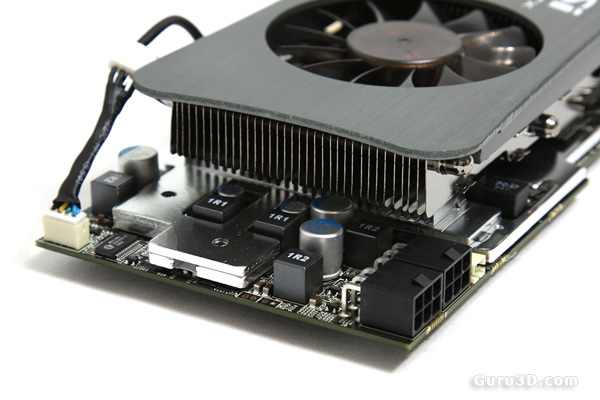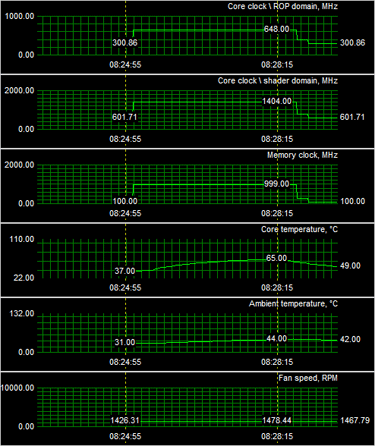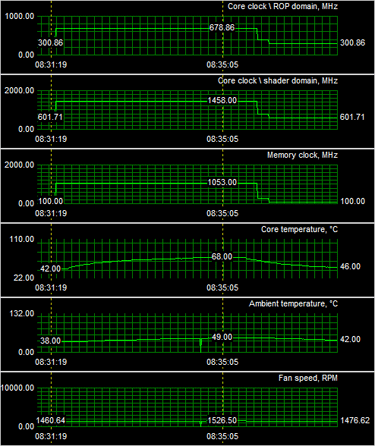Installation | GPU temps | Power consumption | Noise levels
Preparation and setup of the PC
Right, at this stage we are going to insert and connect the graphics card into our test setup. Installing the card into your system will be a fairly easy job. Just slide the card into a free PCIe x8/x16 slot, connect the DVI cable to one of the DVI connectors, connect both the 6-pin power connectors to the card.
Especially with a card like this... I do recommend you buy a decent PSU with some reserves, always. The PSU is an extremely important component in your PC. We'll get into that in a minute though.
Once the card is installed we startup Windows. We install our driver, reboot and you should be good to go. The card will work straight out of the box.

The 6-pin power connectors. The tiny connector is the S/PDIF lead.
Power Consumption
The 55nm GeForce GTX 260 (55nm) has a ~168W TDP. This MSI version however is pre-overclocked though, and as such that number will be slightly higher.
We'll show you some tests we have done on overall power consumption of the PC. Looking at it from a performance versus wattage point of view, the power consumption is not as bad as I expected it to be. Looking at it from a performance versus wattage point of view, the power consumption is really good with the new 55nm products.
Sidenote: We recently upgraded our test-platform, which by itself utilizes a lot of energy.
The new test PC is based on Core i7 965 / X58 based and overclocked to 3.75 GHz. Next to that we have energy saving functions disabled for this motherboard and processor (to ensure consistent benchmark results).
The ASUS motherboard also allows adding power phases for stability, which we enabled as well. I'd say in total on average we are using roughly 50 to 100 Watts more than a standard PC due to these high-end settings and then add to that the CPU overclock, water-cooling, UV lights, optical drive and HDDs. Keep that in mind.
Our normal system power consumption is higher than the average system.
- System in IDLE = 238 Watts
- System with GPU in FULL Stress = 410 Watts
Now then, 410-238= 172 Watts, which is our TDP. 172w:12v= 14 AMP in total.
Recommended Power Supply
So here's my power supply recommendation:
GeForce GTX 260
- A GeForce GTX 260 requires you to have a 550~600 Watt power supply unit at minimum if you use it in a high-end system. That power supply needs to have (in total accumulated) at least 40 Amps available in total on the 12 volts rails.
GeForce GTX 260 SLI
- A second GeForce GTX 260 requires you to have a 750 Watt power supply unit at minimum if you use it in a high-end system. That power supply needs to have (in total accumulated) at least 50 Amps available on the 12 volts rails.
There are many good PSU's out there, please do have a look at our many PSU reviews as we have loads of recommended PSU's for you to check out in there. What would happen if your PSU can't cope with the load?:
- bad 3D performance
- crashing games
- spontaneous reset or imminent shutdown of the PC
- freezes during gameplay
- PSU overload can cause it to break down
Noise Levels coming from the graphics card
When graphics cards produce a lot of heat, usually that heat needs to be transported away from the hot core as fast as possible. Often you'll see massive active fan solutions that can indeed get rid of the heat, yet all the fans these days make the PC a noisy son of a gun. I'm doing a little try out today with noise monitoring, so basically the test we do is extremely subjective. We bought a certified dBA meter and will start measuring how many dBA originate from the PC. Why is this subjective you ask? Well, there is always noise in the background, from the streets, from the HD, PSU fan etc etc, so this is by a mile or two not a precise measurement. You could only achieve objective measurement in a sound test chamber.
The human hearing system has different sensitivities at different frequencies. This means that the perception of noise is not at all equal at every frequency. Noise with significant measured levels (in dB) at high or low frequencies will not be as annoying as it would be when its energy is concentrated in the middle frequencies. In other words, the measured noise levels in dB will not reflect the actual human perception of the loudness of the noise. That's why we measure the dBA level. A specific circuit is added to the sound level meter to correct its reading in regard to this concept. This reading is the noise level in dBA. The letter A is added to indicate the correction that was made in the measurement. Frequencies below 1kHz and above 6kHz are attenuated, where as frequencies between 1kHz and 6kHz are amplified by the A weighting.
| TYPICAL SOUND LEVELS | ||
| Jet takeoff (200 feet) | 120 dBA | |
| Construction Site | 110 dBA | Intolerable |
| Shout (5 feet) | 100 dBA | |
| Heavy truck (50 feet) | 90 dBA | Very noisy |
| Urban street | 80 dBA | |
| Automobile interior | 70 dBA | Noisy |
| Normal conversation (3 feet) | 60 dBA | |
| Office, classroom | 50 dBA | Moderate |
| Living room | 40 dBA | |
| Bedroom at night | 30 dBA | Quiet |
| Broadcast studio | 20 dBA | |
| Rustling leaves | 10 dBA | Barely audible |
So as you guys have learned already, we retested this card for a secind time with a new review sample. OUr first card as it seems was defective. It was showing really high tempeartures, adn as such the fan started spinning abobe 70% RPM.
The new sample I'm happy to report is very silent.
- With the graphics card in idle you can expect a 38 DBa reading.
- Once the card is fully stressed with a shader intensive application we end at roughly 40-41 DBa. At that point the fan is spinnign at 25-30%, and as such is excellent and quiet.
All in all, the final results are really good.
The core temperature
Let's have a look at the temperatures this huge cooler offers.
 |
 |
| Standard Lightning clocks - 648 Mhz core | Lightning Airforce box OC at 680 MHz core |
Now I spilled the beans already with the sound pressure test. But the 2nd sample we received was showing brilliant stuff. No more 100 Degrees C temperatrues on the GPU. Our first test sample definitely was defective.
To the left you can see (click to enlarge) card at default (overclocked) at 650 MHz. Notice that the card is now idling at 37 Degrees C /99 F. Once we stress is with Furmark we now end at 65 degrees C /149 F.
That completely changes the picture doesn't it ? I mean this is a default overclock, completely silent yet we peak at only 65 Degrees C. That's just Perfect.
To the right you can see the card overclocked with the help of the Airforce panel. We add another 30 MHz to the core, 50 extra on the shader processors and the memory at 1053 MHz (x2). Again we see very good temperature control. We end at 68 Degrees C / 154 degrees F when we stress the GPU with Furmark.
I'm happy to report that my previous results with the defective sample can be thown away in the trashbin. What you guys see here is just really good.
Good stuff, let's head onwards to tests and benchmarks.
